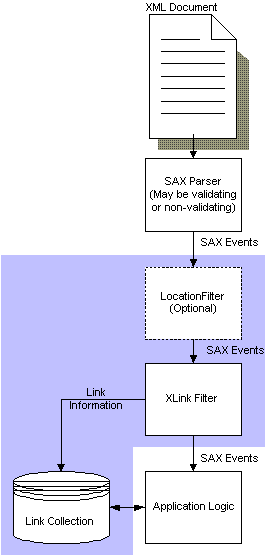As shown in Figure 1 (to the right) the XLink Filter uses John Cowan's ParserFilter class to insert itself between the parser and the application. The XLink filter (derived from the ParserFilter) passes all SAX events on to the application, which can do its own processing of the XML document represented by the SAX events, but only after noting all the XLink information contained in the document. (A LocationFilter class may optionally be inserted between the SAX parser and the XLinkFilter to provide more information about inline links.) When the parsing process is complete, the XLink Filter will leave behind a Link Collection, which can take requests from the Application regarding which elements contain links and what the targets and behaviors of those links should be.
The application will still need to implement the user interface for the links. Highlighting and traversing links will be done in very different ways for image maps and text documents, to cite just one example. The main thing the application will gain from the XLink Filter is convenience - developers won't have to build the XLink processing into their SAX event handlers, and can use a standard interface to linking information rather than having to rebuild that interface with each new application. At present, this model may also assist developers contending with the instability of the XLink specifications - only the Filter's code should need to change to reflect revisions in the standards, not the code of the applications. (Of course, it also depends on the nature of the changes to the spec - drastic changes may in fact require changes to the applications.) This isolation from the details of the XLink spec should hopefully allow multiple applications to implement XLink in a consistent way, easing the adoption of this crucial spec for hypertext development.
It should be noted that at present the XLink Filter is only supporting XLink, and not the accompanying XPointer specification. (XPointers may be created to identify the origins of inline links, using the LocationFilter.) If someone else would like to develop an open source Java XPointer implementation, it could fit neatly between the Link Collection and the Application Logic in Figure 1. Unfortunately, supporting the full range of XPointer possibilities is well beyond my programming skills at this point.

Figure 1 - Event and Link Flows